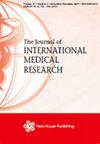Periprosthetic bone mineral density, assessed using dual energy x-ray absorptiometry, following arthroplasty in patients with femoral neck fracture: 5-year outcomes of a randomized controlled trial
IF 1.4
4区 医学
Q4 MEDICINE, RESEARCH & EXPERIMENTAL
引用次数: 0
Abstract
ObjectiveThe relationship between the surgical approach used for hemiarthroplasty and periprosthetic bone mineral density (BMD) is not well understood. We have previously described a decrease in BMD 1 year postoperatively. Here, we assessed the medium-term changes in periprosthetic BMD.MethodsWe performed a follow-up study of patients with femoral neck fracture (FNF) who underwent uncemented hemiarthoplasty using a direct lateral or anterolateral approach. Dual-energy X-ray absorptiometry (DXA) was used to evaluate the changes in BMD in 23 patients over 5 years.ResultsA mean 6% loss of total BMD occurred over 1 year, but between 1 and 5 years, BMD was restored to the baseline value. The mean total BMD in the anterolateral group had decreased by 2% after 3 months and 3% after 12 months, and increased by 2% after 5 years, vs. decreases of 7%, 8%, and 3% for the direct lateral group. Between 1 and 5 years, BMD increased in Gruen zones 2, 3, 4, 5, and 6 in both groups. There was a significantly larger increase in zone 4 in the lateral group (4%) than the anterolateral group.ConclusionThe surgical approach affects periprosthetic BMD in patients with FNF. Furthermore, BMD is restored to the baseline value 5 years postoperatively. ClinicalTrials.gov registration number: NCT03753100.股骨颈骨折患者关节置换术后使用双能 X 射线吸收测量法评估假体周围骨矿物质密度:随机对照试验的 5 年结果
目的半关节成形术采用的手术方法与假体周围骨矿物质密度(BMD)之间的关系尚不十分清楚。我们曾描述过术后 1 年的 BMD 下降情况。我们对采用直接外侧或前外侧方法接受非骨水泥半关节成形术的股骨颈骨折(FNF)患者进行了随访研究。结果 1 年内总 BMD 平均下降了 6%,但在 1 到 5 年间,BMD 恢复到了基线值。前外侧组的平均总 BMD 在 3 个月后下降了 2%,12 个月后下降了 3%,5 年后增加了 2%,而直接外侧组分别下降了 7%、8% 和 3%。1 至 5 年间,两组患者格鲁恩区 2、3、4、5 和 6 的 BMD 均有所增加。外侧组第 4 区的增加幅度(4%)明显高于前外侧组。此外,BMD 在术后 5 年可恢复到基线值。ClinicalTrials.gov 注册号:NCT03753100:NCT03753100。
本文章由计算机程序翻译,如有差异,请以英文原文为准。
求助全文
约1分钟内获得全文
求助全文
来源期刊
CiteScore
3.20
自引率
0.00%
发文量
555
审稿时长
1 months
期刊介绍:
_Journal of International Medical Research_ is a leading international journal for rapid publication of original medical, pre-clinical and clinical research, reviews, preliminary and pilot studies on a page charge basis.
As a service to authors, every article accepted by peer review will be given a full technical edit to make papers as accessible and readable to the international medical community as rapidly as possible.
Once the technical edit queries have been answered to the satisfaction of the journal, the paper will be published and made available freely to everyone under a creative commons licence.
Symposium proceedings, summaries of presentations or collections of medical, pre-clinical or clinical data on a specific topic are welcome for publication as supplements.
Print ISSN: 0300-0605

 求助内容:
求助内容: 应助结果提醒方式:
应助结果提醒方式:


